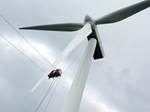Leading-edge erosion: Materials solutions
Depending on operating conditions, erosion of rotor blade leading edges can affect wind turbine energy generation efficiency as soon as two years after installation.
Depending on operating conditions, erosion of rotor blade leading edges can affect wind turbine energy generation efficiency as soon as two years after installation. This too-early onset of erosion has prompted blade manufacturers to address the issue in the design stage, says Gerry Bender, business development manager, Wind Energy Services (WES, Gainesville, Texas). “There are numerous solutions being tried and evaluated in the field,” he notes, “including more durable coatings and tapes.”
For example, 3M (St. Paul, Minn.) is partnering with blade maintenance firm Rope Partner Inc. (Santa Cruz, Calif.) to conduct a year-long, in-field study of leading-edge blade damage.
“We’ve applied 3M protective tape, and we’re currently gathering power curve data compared to adjacent turbines with severe leading-edge erosion,” explains Rope Partner’s blade services manager, Josh Crayton. 3M Wind Protection Tape (WPT) is designed to mitigate the output losses from leading-edge erosion. WPT is made of transparent, abrasion-resistant and UV-resistant polyurethane elastomer.
Related Content
-
Infinite Composites: Type V tanks for space, hydrogen, automotive and more
After a decade of proving its linerless, weight-saving composite tanks with NASA and more than 30 aerospace companies, this CryoSphere pioneer is scaling for growth in commercial space and sustainable transportation on Earth.
-
MingYang reveals 18-MW offshore wind turbine model with 140-meter-long blades
The Chinese wind turbine manufacturer surpasses its 16-MW platform, optimizes wind farm construction costs for 1-GW wind farms.
-
RTM, dry braided fabric enable faster, cost-effective manufacture for hydrokinetic turbine components
Switching from prepreg to RTM led to significant time and cost savings for the manufacture of fiberglass struts and complex carbon fiber composite foils that power ORPC’s RivGen systems.











